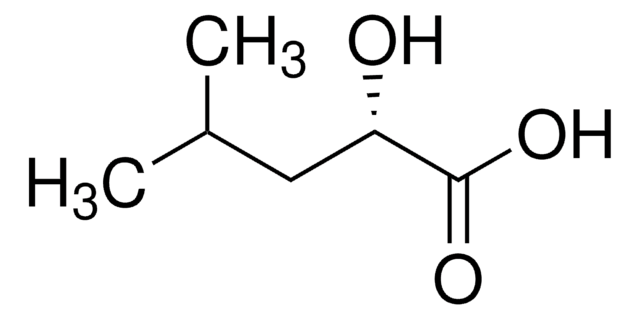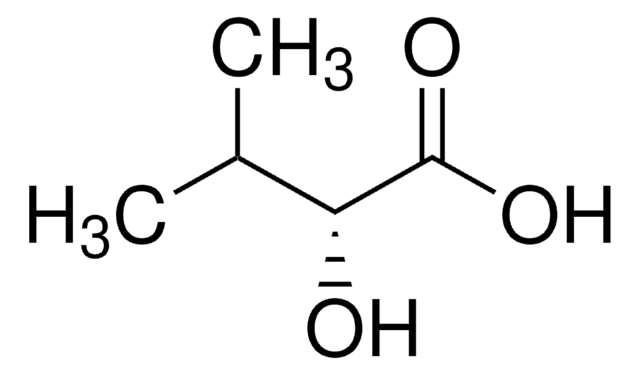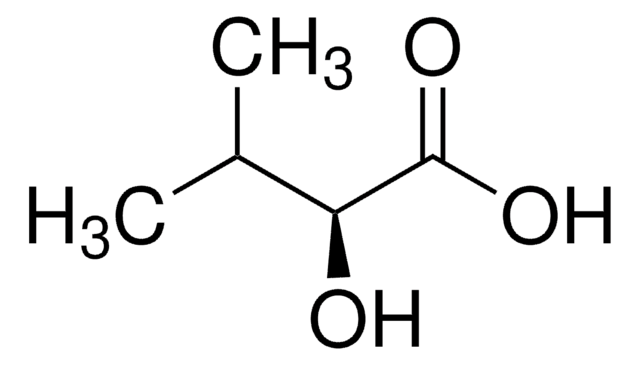219819
2-Hydroxyisocaproic acid
99%
Synonym(s):
2-Hydroxy-4-methylvaleric acid, DL-leucic acid
Sign Into View Organizational & Contract Pricing
All Photos(1)
About This Item
Linear Formula:
(CH3)2CHCH2CH(OH)CO2H
CAS Number:
Molecular Weight:
132.16
EC Number:
MDL number:
UNSPSC Code:
12352100
PubChem Substance ID:
NACRES:
NA.22
Recommended Products
Assay
99%
mp
78-80 °C (lit.)
SMILES string
CC(C)CC(O)C(O)=O
InChI
1S/C6H12O3/c1-4(2)3-5(7)6(8)9/h4-5,7H,3H2,1-2H3,(H,8,9)
InChI key
LVRFTAZAXQPQHI-UHFFFAOYSA-N
Related Categories
Storage Class Code
11 - Combustible Solids
WGK
WGK 3
Flash Point(F)
Not applicable
Flash Point(C)
Not applicable
Certificates of Analysis (COA)
Search for Certificates of Analysis (COA) by entering the products Lot/Batch Number. Lot and Batch Numbers can be found on a product’s label following the words ‘Lot’ or ‘Batch’.
Already Own This Product?
Find documentation for the products that you have recently purchased in the Document Library.
Customers Also Viewed
Extraction-spectrophotometric determination of antimony (V) with 2-hydroxyisocaproic acid and citrate, with application to differential determination of antimony (V) and antimony (III).
SATO S and UCHIKAWA S.
Analytical Sciences, 2, 47-47 (1986)
Polymer, Assisted Solution Phase Synthesis of tr, Ketoamides.
Parlow JJ, et al.
High-Throughput Synthesis: Principles and Practices, 143-143 (2001)
K D Webster et al.
Archives of biochemistry and biophysics, 273(2), 562-571 (1989-09-01)
L-Thiomorpholine-3-carboxylic acid (L-TMC) is a cyclized analog of S-(2-chloroethyl)-L-cysteine, which is cytotoxic in vitro and nephrotoxic in vivo. To determine whether L-TMC may play a role in S-(2-chloroethyl)-L-cysteine-induced toxicity, the cytotoxicity of L-TMC was studied in isolated rat kidney cells.
Veronika Walser et al.
Molecules (Basel, Switzerland), 26(5) (2021-04-04)
The emetic Bacillus cereus toxin cereulide presents an enormous safety hazard in the food industry, inducing emesis and nausea after the consumption of contaminated foods. Additional to cereulide itself, seven structurally related isoforms, namely the isocereulides A-G, have already been
David Selis et al.
Journal of endodontics, 45(5), 578-583 (2019-03-19)
A successful outcome of root canal therapy relies on effective disinfection of the root canal system, including the use of intracanal medicaments, which vary in their bactericidal and cytotoxic properties. Assessing the benefits and risks associated with the use of
Our team of scientists has experience in all areas of research including Life Science, Material Science, Chemical Synthesis, Chromatography, Analytical and many others.
Contact Technical Service












